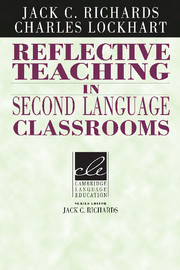Book contents
- Frontmatter
- Contents
- Series editor's preface
- Preface
- Introduction: Teacher development through exploring classroom processes
- 1 Approaches to classroom investigation in teaching
- 2 Exploring teachers' beliefs
- 3 Focus on the learner
- 4 Teacher decision making
- 5 The role of the teacher
- 6 The structure of a language lesson
- 7 Interaction in the second language classroom
- 8 The nature of language learning activities
- 9 Language use in the classroom
- Epilogue
- References
- Index
Preface
Published online by Cambridge University Press: 29 January 2010
- Frontmatter
- Contents
- Series editor's preface
- Preface
- Introduction: Teacher development through exploring classroom processes
- 1 Approaches to classroom investigation in teaching
- 2 Exploring teachers' beliefs
- 3 Focus on the learner
- 4 Teacher decision making
- 5 The role of the teacher
- 6 The structure of a language lesson
- 7 Interaction in the second language classroom
- 8 The nature of language learning activities
- 9 Language use in the classroom
- Epilogue
- References
- Index
Summary
Reflective Teaching in Second Language Classrooms is designed for use in pre-service and in-service teacher education programs offering a teaching practicum or courses on classroom observation, theories of teaching, or language teaching methods and approaches. Instructors can use the book as a basis for either individual or collaborative teacher development activities, including peer observation, self-evaluation, program evaluation, and action research.
Each chapter presents an important dimension of teaching and poses questions that form the basis for classroom observation and investigation as well as critical reflection. The suggested small-scale investigative tasks can be carried out by teachers or student teachers in a variety of classroom situations.
Chapter 1 provides an introduction to classroom investigation procedures, including teaching journals, lesson reports, surveys and questionnaires, audio and video recording, observation, and action research. Chapter 2 examines how teachers' ideas and beliefs about teaching and learning can influence their classroom practices. Chapter 3 deals with learners' beliefs, goals, and attitudes and how these influence their learning styles and strategies. Chapter 4 discusses the thinking processes underlying teaching and considers three areas of decision-making: planning, interactive, and evaluative decisions. Chapter 5 examines the roles teachers perform in their institutions and their own classrooms, the responsibilities these roles create, and how they contribute to the instructor's teaching style. Chapter 6 explores how teaching events are structured and how different structuring choices can influence the coherence and dynamics of a lesson. Chapter 7 focuses on the nature of classroom interaction, the interaction patterns typical of second language classrooms,and ways in which teachers can influence these patterns.
Information
- Type
- Chapter
- Information
- Reflective Teaching in Second Language Classrooms , pp. xi - xiiPublisher: Cambridge University PressPrint publication year: 1994
Accessibility standard: Unknown
Why this information is here
This section outlines the accessibility features of this content - including support for screen readers, full keyboard navigation and high-contrast display options. This may not be relevant for you.Accessibility Information
- 2
- Cited by
